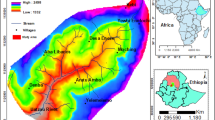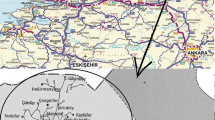Abstract
The legislation that demands the evaluation of landslide susceptibility in Portugal at the municipal level is the National Ecological Reserve (NER). A methodology for the evaluation of landslide susceptibility to be used in municipal planning is applied in Loures Municipality (169.3 km²) located north of Lisbon (Portugal). A landslide inventory was made for the whole area interpreting orthophoto maps and aerial photographs and using standard geomorphologic techniques in field work. It consists of 686 polygons, each polygon representing a rotational, a deep translational or a shallow translational slide, and is integrated into a GIS database. Landslide susceptibility is evaluated using algorithms based on statistical/probabilistic analysis (Information Value Method) over unique-condition terrain units in a raster basis. Three susceptibility models are elaborated independently according to the type of slide (rotational, deep translational, shallow translational). The landslide susceptibility maps are prepared by sorting all pixels according to the pixel susceptibility value in descending order. The robustness and accuracy of the landslide susceptibility models are evaluated by prediction-rate curves, which are used for the quantitative interpretation of the landslide susceptibility maps. Unstable slopes that have to be included into the National Ecological Reserve are extracted from the three susceptibility maps following the general rules to draw the NER that state that the area to be included in the NER should guarantee the inclusion of at least 70 % of the landslides identified in the landslide inventory. The obtained results allow us to conclude that 70 % of the future landslides should occur in these areas, classified as most susceptible to landslides corresponding to 20.3 % of the total area of Municipality. Thus, the consideration of these 20.3 % as regards prevention and protection of landslide risk could potentially reduce damage resulting from 70 % of future landslides in the Loures Municipality.








Similar content being viewed by others
References
Bi J, Bennett K (2003) Regression error characteristic curves. Twentieth International Conference on Machine Learning (ICML-2003). Washington, DC
Carrara A, Guzzeti F, Cardinali P, Reichenbach M (1998) Current limitations in modeling landslide hazards. In: Buccianti A, Nardi G, Potenza R (eds) Proceedings of IAMG’98
Carvalho J, Pinto C, Costa M, Heleno S, Silva M, Rabeh T, Cooksley G, Carrilho F (2008) Improving the Seismic Hazard Evaluation of the Lisbon and Lower Tagus Valley Area. 14th European Meeting of Environmental and Engineering Geophysics. Near Surface 2008, Kraków, Poland
Chacón J, Irigaray C, Fernández T, El Hamdouni R (2006) Engineering geology maps: landslides and geographical information systems. Bulletin of Engineering Geology and the Environment 65:341–411
Chung C, Fabbri A (2003) Validation of spatial prediction models for landslide hazard mapping. Natural Hazards 30:451–472
Chung C, Fabbri A (2005) Systematic Procedures of Landslide Hazard Mapping for Risk assessment Using Spatial Prediction Models. In: Glade T, Anderson M, Crozier M (eds) Landslide hazard and Risk, p 139–174
CNREN (2010) Comissão Nacional da Reserva Ecológica Nacional (REN). Projecto de Orientações Estratégicas de âmbito Nacional. Projecto de Esquema Nacional de Referência
Dai F, Lee C, Ngai Y (2002) Landslide risk assessment and management: an overview. Engineering Geology 64:65–87
Garcia R, Zêzere J, Oliveira S (2007) A importância do processo de classificação de dados na cartografia: um exemplo na cartografia de susceptibilidade a movimentos de vertente. In: Pereira A, Trindade J, Garcia R, Oliveira S (eds) Dinâmicas Geomorfológicas. Metodologias. Aplicação. Publicações da Associação Portuguesa de Geomorfólogos. Lisboa, APGEOM, V:265–279
Günther A, Reichenbach P, Hervás J (2008) Approaches for delineating areas susceptible to landslides in the framework of the european soil thematic strategy. In: Proceedings of the first world landslide forum, p 235–238
Guzzetti F (2005) Landslide hazard and risk assessment. Concepts, methods and tools for the detection and mapping of landslides, for landslide susceptibility zonation and hazard assessment, and for landslide risk evaluation. PhD Thesis, Bonn
Guzzetti F, Carrara A, Cardinali M, Reichenbach P (1999) Landslide hazard evaluation: a review of current techniques and and their application in a multi-scale study, Central Italy. Geomorphology 31:181–216
Guzzetti F, Reichenbach P, Cardinali M, Galli M, Ardizzone F (2005a) Landslide hazard assessment in the Staffora basin, northern Italian Apennines. Geomorphology 72:272–299
Guzzetti F, Reichenbach P, Cardinali M, Galli M, Ardizzone F (2005b) Probabilistic landslide hazard assessment at the basin scale. Geomorphology 72:272–299
Guzzetti F, Reichenbach P, Ardizzone F, Cardinali M, Galli M (2006) Estimating the quality of landslide susceptibility models. Geomorphology 81:166–184
Lopes da Fonseca I (2005) Modelling soil properties at the landscape scale in a desertification context. Department of Geography, King’s College London, London
Malamud B, Turcotte D, Guzzetti F, Reichenbach P (2004) Landslide inventories and their statistical properties. Earth Surface Processes and Landforms 29:687–711
Malet J, Maquaire O (2008) Risk assessment methods of landslides. Ramsoil, risk assessment methodologies for soil threats, Sixth Framework Programme, Project Report 2.2, Deliverable 2.3.2.4
Moreira V (1985) Seismotectonics of Portugal and its adjacent area in the Atlantic. Tectonophysics 117:85–96
Pereira S, Zêzere J, Bateira C (2012) Technical Note: Assessing predictive capacity and conditional independence of landslide predisposing factors for shallow landslides susceptibility models. Natural Hazards and Earth System Sciences 12:979–988
Soeters R, Van Westen C (1996) Slope instability recognition, analysis and zonation. In: Turner AK, Schuster RL (eds) Landslides. Investigation and mitigation. National Academy Press, Washington DC, pp 129–177
Van Westen C, Castellanos E, Kuriakose S (2008) Spatial data for landslide susceptibility, hazard, and vulnerability assessment: an overview. Engineering Geology 102:112–131
Varnes D et al (1984) Landslide hazard zonation: a review of principles and practice. UNESCO Press, Paris
Vaz T, Zêzere J (2011) Landslides induced by seismic events in Portugal mainland: identification and characterization. Geophysical Research Abstracts, Vol.13, EGU2011-4802, EGU General Assembly 2011
Vilanova S, Fonseca J (2007) Probabilistic Seismic-Hazard Assessment for Portugal. Bulletin of the Seismological Society of America 97(5):1702–1717
Yin K, Yan T (1988) Statistical prediction models for slope instability of metamorphosed rocks. In: Bonnard C (ed) Landslides, Proceedings of the fifth international symposium on landslides, Balkema, Rotterdam, p 1269–1272
Zêzere J (2002) Landslide susceptibility assessment considering landslide typology. A case study in the area north of Lisbon (Portugal). Natural Hazards and Earth System Sciences 2:73–82
Zêzere J, Ferreira A, Rodrigues M (1999) The role of conditioning and triggering factors in the occurrence of landslides’: a case study in the area north of Lisbon (Portugal). Geomorphology 30(1–2):133–146
Zêzere J, Reis E, Oliveira S (2004a) Integration of spatial and temporal data for the definition of different landslide hazard scenarios in the area north of Lisbon (Portugal). Natural Hazards and Earth System Sciences 4:133–146
Zêzere J, Rodrigues M, Reis E (2004b) Spatial and temporal data management for the probalilistic landslide hazard assessment considering landslide typology. In: Lacerda W, Ehrlich M, Fontoura S, Sayao A (eds) Landslides evaluation and stabilization, vol 1, p 117–123
Zêzere J, Trigo R, Trigo I (2005) Shallow and deep landslides induced by rainfall in the Lisbon region (Portugal): assessment of relationships with the North Atlantic Oscillation. Natural Hazards and Earth System Sciences 5:331–344
Zêzere J, Trigo R, Fragoso M, Oliveira S, Garcia R (2008a) Rainfall-triggered landslides occurred in the Lisbon Region in 2006: validation of regional rainfall thresholds and relationships with the North Atlantic Oscillation. Natural Hazard and Earth System Sciences 8:483–499
Zêzere J, Garcia R, Oliveira S, Reis E (2008b) Probabilistic landslide risk analysis considering direct costs in the area north of Lisbon (Portugal). Geomorphology 94:467–495
Zêzere J, Henriques C, Garcia R, Oliveira S, Piedade A, Neves M (2009) Effects of landslide inventories uncertainty on landslide susceptibility modeling assessment at the regional scale. In: Malet J.-P, Remaître A, Bogaard T (eds) Procedings of the landslide processes. From geomorphologic mapping to dynamic modeling conference. A tribute to Prof. Theo van Asch, CERG Editions, Strasbourg, p 81–86
Acknowledgments
This work was supported by the MapRisk Project (PTDC/GEO/68227/2006), financed by the Foundation for Science and the Technology (FCT), and by the Développement d’Outils pour le Suivi des Mouvements de Sols dans le but d’aider au développement durable de la région SUDOE, (DO-SMS-SOE1/P2/F157), Interreg IV B. The first author is a PhD fellow funded by FCT (SFRH/BD/64973/2009). We are grateful to five anonymous reviewers whose comments and suggestions helped to improve the quality of this paper.
Author information
Authors and Affiliations
Corresponding author
Rights and permissions
About this article
Cite this article
Guillard, C., Zezere, J. Landslide Susceptibility Assessment and Validation in the Framework of Municipal Planning in Portugal: The Case of Loures Municipality. Environmental Management 50, 721–735 (2012). https://doi.org/10.1007/s00267-012-9921-7
Received:
Accepted:
Published:
Issue Date:
DOI: https://doi.org/10.1007/s00267-012-9921-7




